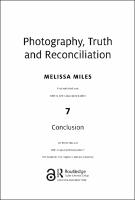Chapter 7 Conclusion
Proposal review
| dc.contributor.author | Miles, Melissa | |
| dc.date.accessioned | 2022-06-28T08:20:02Z | |
| dc.date.available | 2022-06-28T08:20:02Z | |
| dc.date.issued | 2020 | |
| dc.identifier.uri | https://library.oapen.org/handle/20.500.12657/57126 | |
| dc.description.abstract | The notion that photographs are the products of biases and hidden agendas is nothing new. Photographs have presented Argentina’s Proceso as a source of peace and stability, Canada’s residential schools as agents of successful assimilation and the Extraordinary Chambers in the Courts of Cambodia as an unimpeachable force for justice. Photography has proven a valuable partner in these endeavours. Photographs provide evocative visual, temporal and material links to the past that allow them to be used as evidence, affirmations of different types of truth, political critique, and individual and shared historical narratives. Contemporary patterns of international photography education, exhibition, theorization and publication reaffirm the critical necessity of bringing a deterritorialized perspective to national case studies. Contemporary photographers are deterritorializing their responses to human rights abuses by forging connections between different historical events across time and space. | en_US |
| dc.language | English | en_US |
| dc.subject.other | history of photography, art history, visual studies | en_US |
| dc.title | Chapter 7 Conclusion | en_US |
| dc.type | chapter | |
| oapen.identifier.doi | 10.4324/9781003103820-7 | en_US |
| oapen.relation.isPublishedBy | 7b3c7b10-5b1e-40b3-860e-c6dd5197f0bb | en_US |
| oapen.relation.isPartOfBook | bdbf6e49-294c-4b01-b537-350097b64f83 | en_US |
| oapen.relation.isFundedBy | fba673a1-ae6a-4dd4-91dd-32bdd6d35a1e | en_US |
| oapen.relation.isbn | 9781032220239 | en_US |
| oapen.relation.isbn | 9781474296069 | en_US |
| oapen.imprint | Routledge | en_US |
| oapen.pages | 9 | en_US |
| peerreview.anonymity | Single-anonymised | |
| peerreview.id | bc80075c-96cc-4740-a9f3-a234bc2598f1 | |
| peerreview.open.review | No | |
| peerreview.publish.responsibility | Publisher | |
| peerreview.review.stage | Pre-publication | |
| peerreview.review.type | Proposal | |
| peerreview.reviewer.type | Internal editor | |
| peerreview.reviewer.type | External peer reviewer | |
| peerreview.title | Proposal review | |
| oapen.review.comments | Taylor & Francis open access titles are reviewed as a minimum at proposal stage by at least two external peer reviewers and an internal editor (additional reviews may be sought and additional content reviewed as required). |

